NASA brings back retro 'worm' logo for upcoming Artemis 2 moon mission (photos)
The iconic logo also returned for limited use in 2020.

The worm is going to the moon.
Artemis 2, the first human moon mission in 50 years, will carry the iconic NASA "worm" logo upon the solid rocket boosters helping to heft the astronauts into space, agency officials stated on Thursday (Feb. 16).
"That's no earthworm you see on SLS! The NASA worm logo is inching into place on our boosters," NASA's official account for the Space Launch System stated on X, formerly Twitter, on Thursday. Each letter of the worm is nearly 7 feet (2 meters) high and the logo is roughly 25 feet (7.5 meters) from end to end.
Related: Astronauts won't walk on the moon until 2026 after NASA delays next 2 Artemis missions
The curvy NASA lettering was also recently painted in a smaller form on the Orion spacecraft that will bear the four astronauts on the round-the-moon mission no earlier than September 2025 during the first crewed excursion for the spacecraft.
The worm logo was first used in 1975 after being designed by Danne & Blackburn, a New York-based studio who recreated the NASA wording under the U.S. Federal Design Improvement Program, according to Design Week.
Worms started crawling their way into space during the joint U.S. and Russian Apollo-Soyuz Test Project in 1975, continuing to inch their way into orbit during the space shuttle and Hubble Space Telescope launching era.
Breaking space news, the latest updates on rocket launches, skywatching events and more!
In 1992, however, then NASA-administrator Dan Goldin retired the worm logo in favor of a "meatball" version to invoke the "glory days" of Apollo, according to agency materials. But the worm made a comeback for limited mission opportunities in 2020, starting with the first SpaceX mission with astronauts on board, under the approval of then-administrator Jim Bridenstine.
"I grew up with the worm as the logo of NASA. It is kind of personal to me," Bridenstine told Space.com partner collectSPACE in 2020. "This is NASA."
Work on the Artemis 2 hardware at NASA's Kennedy Space Center, as well as other locations, continues. The mission was recently delayed nine months to September 2025 due to several technical issues. Delayed too was Artemis 3, now slated for 2026 instead of 2025.
"It takes courage to make the right decision," Artemis 2 astronaut Jeremy Hansen, a mission specialist with the Canadian Space Agency, told Space.com in exclusive interview this month. "In this case," he added, "this one was very clearly the right decision. There are concrete things that we know we will use this time for."
The mission includes NASA commander Reid Wiseman, NASA pilot Victor Glover (who will become the first Black person to leave low Earth orbit, or LEO), NASA mission specialist Christina Koch (the first woman to go beyond LEO) and Hansen (the first non-American).
NASA, Canada and more than 30 other countries have signed up for a set of peaceful space exploration norms under the U.S.-led Artemis Accords. A subset of those countries, like Canada and certain members of the European Space Agency, have committed also to contributing hardware for the Artemis program's moon aims.

Elizabeth Howell (she/her), Ph.D., was a staff writer in the spaceflight channel between 2022 and 2024 specializing in Canadian space news. She was contributing writer for Space.com for 10 years from 2012 to 2024. Elizabeth's reporting includes multiple exclusives with the White House, leading world coverage about a lost-and-found space tomato on the International Space Station, witnessing five human spaceflight launches on two continents, flying parabolic, working inside a spacesuit, and participating in a simulated Mars mission. Her latest book, "Why Am I Taller?" (ECW Press, 2022) is co-written with astronaut Dave Williams.



